2022 HYUNDAI VELOSTER light
[x] Cancel search: lightPage 13 of 446

1-2
EXTERIOR OVERVIEW
Your vehicle at a glance
1. Hood .....................................................3-25
2. Headlamp ....................................3-68, 7-63
3. Daytime running light (DRL) ..................3-72
4. Turn signal lamp ....................................7-645. Tires and wheels ..................................7-32
6. Side view mirror ....................................3-18
7. Wiper blade ..........................................7-26
8. Windows ................................................3-21
OBU018001N
■ Front view
The actual shape may differ from the illustration.
Page 16 of 446
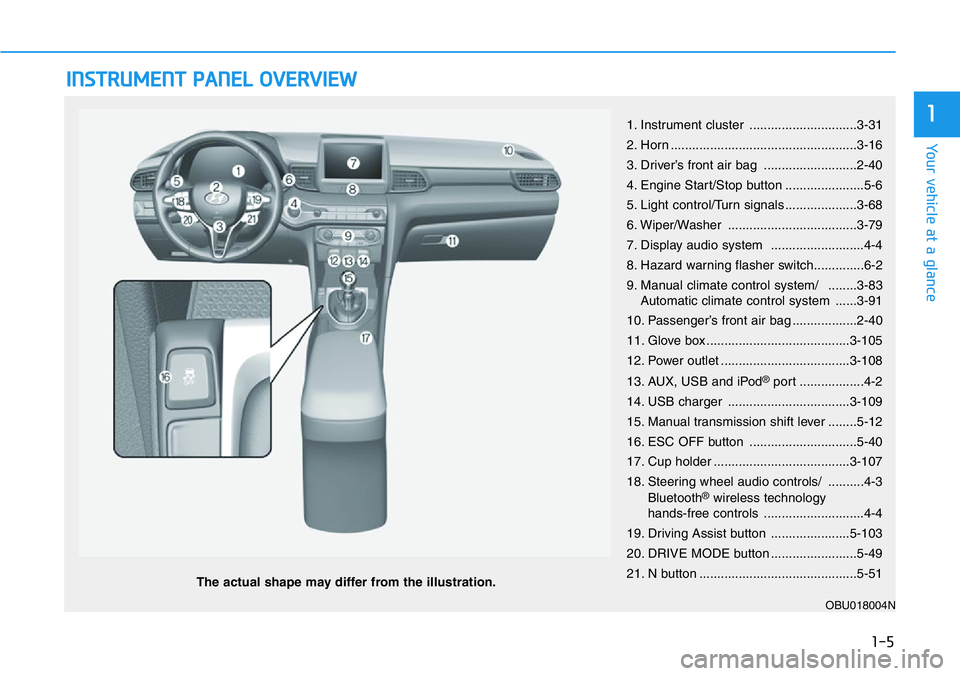
INSTRUMENT PANEL OVERVIEW
The actual shape may differ from the illustration.
1-5
Your vehicle at a glance
11. Instrument cluster ..............................3-31
2. Horn ....................................................3-16
3. Driver’s front air bag ..........................2-40
4. Engine Start/Stop button ......................5-6
5. Light control/Turn signals ....................3-68
6. Wiper/Washer ....................................3-79
7. Display audio system ..........................4-4
8. Hazard warning flasher switch..............6-2
9. Manual climate control system/ ........3-83
Automatic climate control system ......3-91
10. Passenger’s front air bag ..................2-40
11. Glove box ........................................3-105
12. Power outlet ....................................3-108
13. AUX, USB and iPod
®port ..................4-2
14. USB charger ..................................3-109
15. Manual transmission shift lever ........5-12
16. ESC OFF button ..............................5-40
17. Cup holder ......................................3-107
18. Steering wheel audio controls/ ..........4-3
Bluetooth
®wireless technology
hands-free controls ............................4-4
19. Driving Assist button ......................5-103
20. DRIVE MODE button ........................5-49
21. N button ............................................5-51
OBU018004N
Page 18 of 446
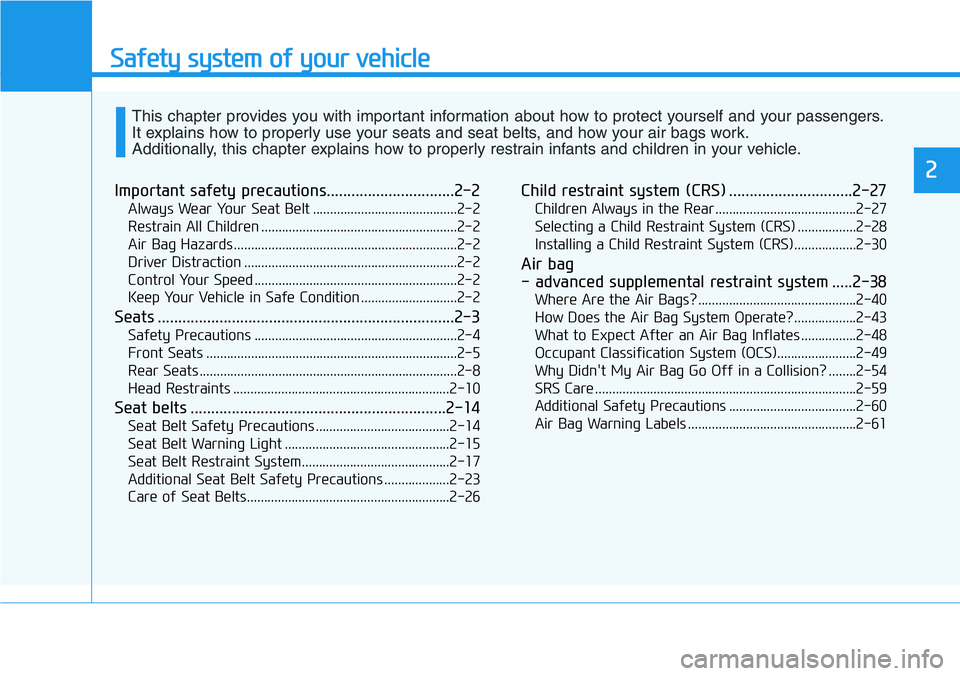
Safety system of your vehicle
Important safety precautions...............................2-2
Always Wear Your Seat Belt ..........................................2-2
Restrain All Children .........................................................2-2
Air Bag Hazards .................................................................2-2
Driver Distraction ..............................................................2-2
Control Your Speed ...........................................................2-2
Keep Your Vehicle in Safe Condition ............................2-2
Seats ........................................................................2-3
Safety Precautions ...........................................................2-4
Front Seats .........................................................................2-5
Rear Seats ...........................................................................2-8
Head Restraints ...............................................................2-10
Seat belts ..............................................................2-14
Seat Belt Safety Precautions .......................................2-14
Seat Belt Warning Light ................................................2-15
Seat Belt Restraint System...........................................2-17
Additional Seat Belt Safety Precautions ...................2-23
Care of Seat Belts...........................................................2-26
Child restraint system (CRS) ..............................2-27
Children Always in the Rear .........................................2-27
Selecting a Child Restraint System (CRS) .................2-28
Installing a Child Restraint System (CRS)..................2-30
Air bag
- advanced supplemental restraint system .....2-38
Where Are the Air Bags? ..............................................2-40
How Does the Air Bag System Operate?..................2-43
What to Expect After an Air Bag Inflates ................2-48
Occupant Classification System (OCS).......................2-49
Why Didn't My Air Bag Go Off in a Collision? ........2-54
SRS Care ............................................................................2-59
Additional Safety Precautions .....................................2-60
Air Bag Warning Labels .................................................2-61
This chapter provides you with important information about how to protect yourself and your passengers.
It explains how to properly use your seats and seat belts, and how your air bags work.
Additionally, this chapter explains how to properly restrain infants and children in your vehicle.
2
Page 22 of 446

2-5
Safety system of your vehicle
2
Front SeatsManual adjustment
The front seat can be adjusted by
using the levers located on the out-
side of the seat cushion. Before driv-
ing, adjust the seat to the proper
position so that you can easily con-
trol the steering wheel, foot pedals
and controls on the instrument
panel. Take the following precautions
when adjusting your seat:
•NEVER attempt to adjust the
seat while the vehicle is mov-
ing. The seat could respond
with unexpected movement
and may cause loss of vehicle
control resulting in an acci-
dent.
•Do not place anything under
the front seats. Loose objects
in the driver's foot area could
interfere with the operation of
the foot pedals, causing an
accident.
•Do not allow anything to inter-
fere with the normal position
and proper locking of the seat-
back.
•Do not place a cigarette lighter
on the floor or seat. When you
operate the seat, gas may exit
out of the lighter causing a fire.
WARNING
To prevent injury:
•Do not adjust your seat while
wearing your seat belt.
Moving the seat cushion for-
ward may cause strong pres-
sure on your abdomen.
•Do not allow your hands or
fingers to get caught in the
seat mechanisms while the
seat is moving.
CAUTION
•Use extreme caution when
picking up small objects
trapped under the seats or
between the seat and the cen-
ter console. Your hands might
be cut or injured by the sharp
edges of the seat mechanism.
Page 23 of 446
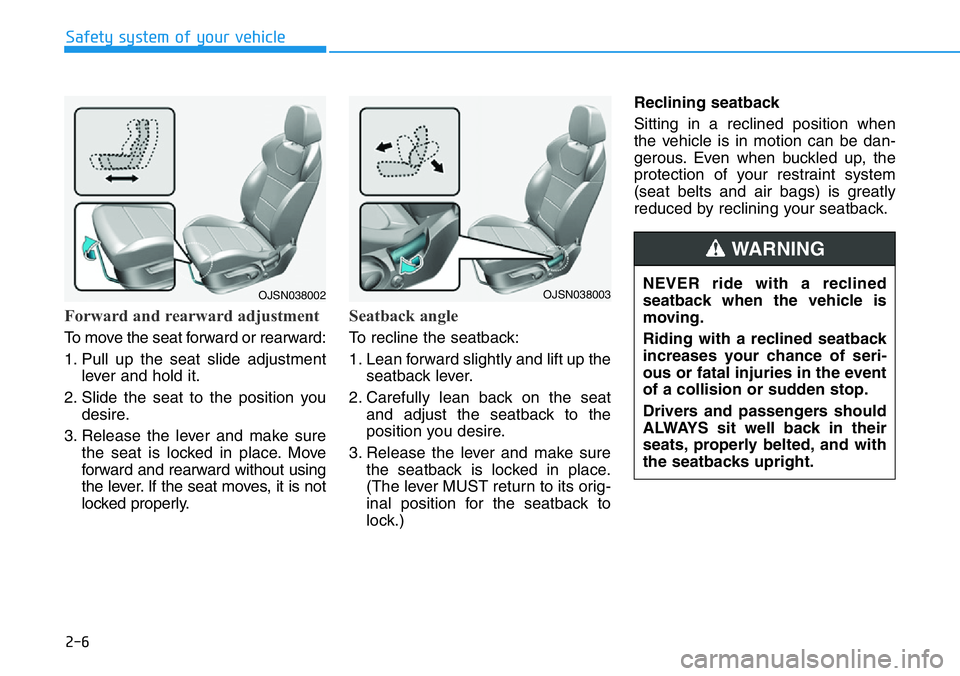
2-6
Safety system of your vehicle
Forward and rearward adjustment
To move the seat forward or rearward:
1. Pull up the seat slide adjustment
lever and hold it.
2. Slide the seat to the position you
desire.
3. Release the lever and make sure
the seat is locked in place. Move
forward and rearward without using
the lever. If the seat moves, it is not
locked properly.
Seatback angle
To recline the seatback:
1. Lean forward slightly and lift up the
seatback lever.
2. Carefully lean back on the seat
and adjust the seatback to the
position you desire.
3. Release the lever and make sure
the seatback is locked in place.
(The lever MUST return to its orig-
inal position for the seatback to
lock.)Reclining seatback
Sitting in a reclined position when
the vehicle is in motion can be dan-
gerous. Even when buckled up, the
protection of your restraint system
(seat belts and air bags) is greatly
reduced by reclining your seatback.
OJSN038002 OJSN038003NEVER ride with a reclined
seatback when the vehicle is
moving.
Riding with a reclined seatback
increases your chance of seri-
ous or fatal injuries in the event
of a collision or sudden stop.
Drivers and passengers should
ALWAYS sit well back in their
seats, properly belted, and with
the seatbacks upright.
WARNING
Page 24 of 446
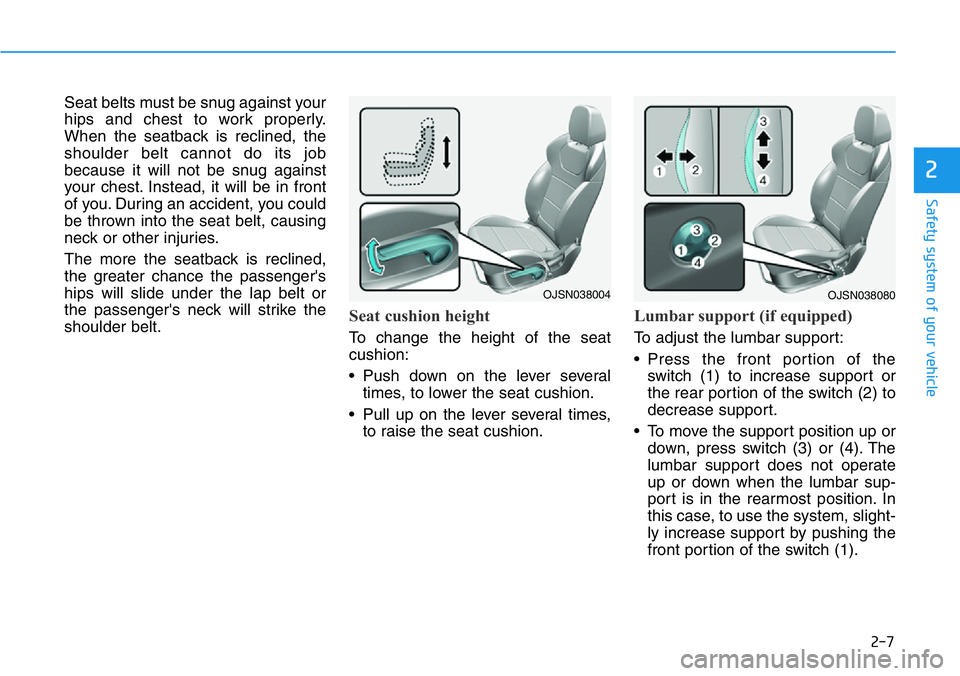
2-7
Safety system of your vehicle
2
Seat belts must be snug against your
hips and chest to work properly.
When the seatback is reclined, the
shoulder belt cannot do its job
because it will not be snug against
your chest. Instead, it will be in front
of you. During an accident, you could
be thrown into the seat belt, causing
neck or other injuries.
The more the seatback is reclined,
the greater chance the passenger's
hips will slide under the lap belt or
the passenger's neck will strike the
shoulder belt.
Seat cushion height
To change the height of the seat
cushion:
• Push down on the lever several
times, to lower the seat cushion.
• Pull up on the lever several times,
to raise the seat cushion.
Lumbar support (if equipped)
To adjust the lumbar support:
• Press the front portion of the
switch (1) to increase support or
the rear portion of the switch (2) to
decrease support.
• To move the support position up or
down, press switch (3) or (4). The
lumbar support does not operate
up or down when the lumbar sup-
port is in the rearmost position. In
this case, to use the system, slight-
ly increase support by pushing the
front portion of the switch (1).
OJSN038004 OJSN038080
Page 30 of 446
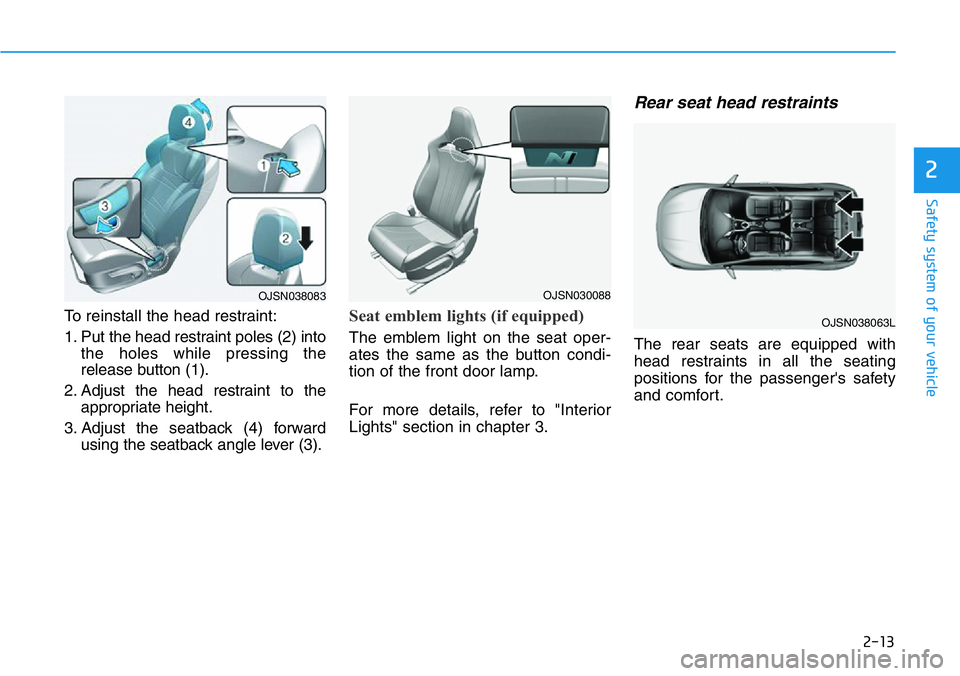
2-13
Safety system of your vehicle
2
To reinstall the head restraint:
1. Put the head restraint poles (2) into
the holes while pressing the
release button (1).
2. Adjust the head restraint to the
appropriate height.
3. Adjust the seatback (4) forward
using the seatback angle lever (3).Seat emblem lights (if equipped)
The emblem light on the seat oper-
ates the same as the button condi-
tion of the front door lamp.
For more details, refer to "Interior
Lights" section in chapter 3.
Rear seat head restraints
The rear seats are equipped with
head restraints in all the seating
positions for the passenger's safety
and comfort.
OJSN038063L
OJSN038083OJSN030088
Page 32 of 446
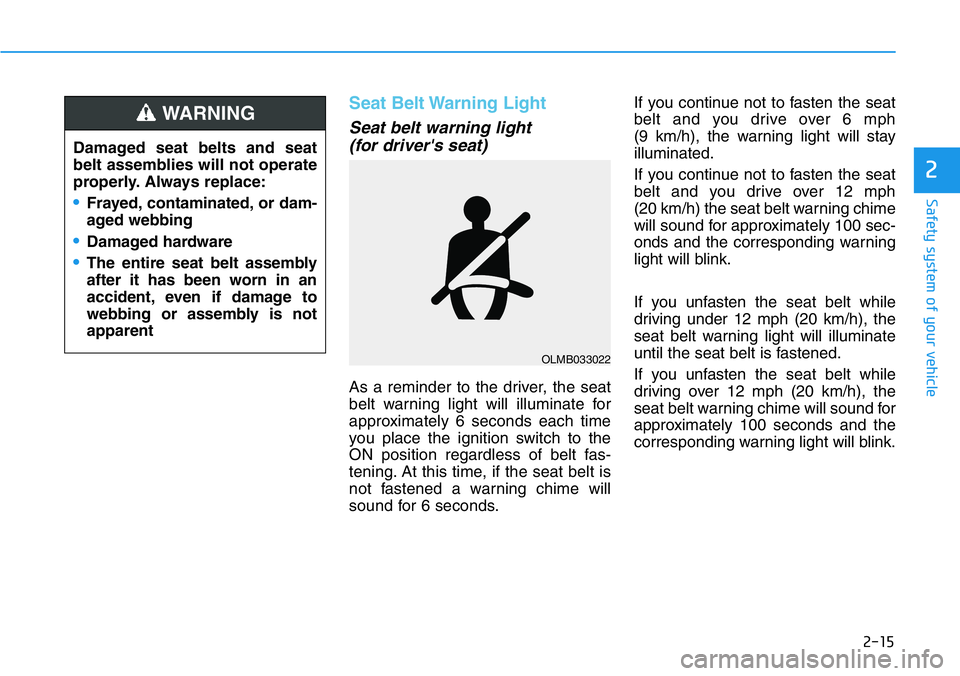
2-15
Safety system of your vehicle
2
Seat Belt Warning Light
Seat belt warning light
(for driver's seat)
As a reminder to the driver, the seat
belt warning light will illuminate for
approximately 6 seconds each time
you place the ignition switch to the
ON position regardless of belt fas-
tening. At this time, if the seat belt is
not fastened a warning chime will
sound for 6 seconds.If you continue not to fasten the seat
belt and you drive over 6 mph
(9 km/h), the warning light will stay
illuminated.
If you continue not to fasten the seat
belt and you drive over 12 mph
(20 km/h) the seat belt warning chime
will sound for approximately 100 sec-
onds and the corresponding warning
light will blink.
If you unfasten the seat belt while
driving under 12 mph (20 km/h), the
seat belt warning light will illuminate
until the seat belt is fastened.
If you unfasten the seat belt while
driving over 12 mph (20 km/h), the
seat belt warning chime will sound for
approximately 100 seconds and the
corresponding warning light will blink. Damaged seat belts and seat
belt assemblies will not operate
properly. Always replace:
•Frayed, contaminated, or dam-
aged webbing
•Damaged hardware
•The entire seat belt assembly
after it has been worn in an
accident, even if damage to
webbing or assembly is not
apparent
WARNING
OLMB033022